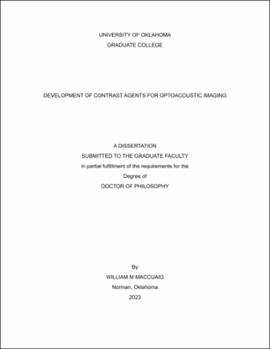| dc.description.abstract | Optoacoustic imaging is an emerging modality with inherent advantages relevant for clinical use. Following excitation of optoacoustic contrast agents with ultrashort (~10 ns) pulses of near-infrared light, thermoelastic contractions and expansions of the molecule are produced and detected as acoustic waves. As the pathlength of light is reduced by half, and since near-infrared light penetrates efficiently in biological tissue, the influence of the imaging depth/spatial resolution tradeoff is significantly diminished; an unavoidable phenomenon in traditional optical imaging. Multiwavelength illumination allows for understanding of optoacoustic signal as a function of excitation wavelength, which can be utilized in unmixing algorithms, a feature that is unavailable with conventional ultrasound. Such unmixing algorithms have the ability to separate and determine the location and concentration of multiple optoacoustic agents in an unknown sample. There is a need for developing improved optoacoustic contrast agents and delivery mechanisms to further increase the applications of optoacoustic imaging. In this dissertation, newly synthesized squaraine and cyanine compounds are extensively characterized to determine how molecular structure directly impacts the ability to generate optoacoustic signal. Specifically, which molecular features result in changes to optoacoustic intensity and spectral shape, e.g., optoacoustic signal vs. wavelength. These studies show that through heavy halogenation, addition of rotatable bonds, and functionalization with diethylamino groups positively impact the strength of the contrast agents and may result in bathochromic shifts. Further, mesoporous silica nanoparticles have shown potential for inert, high cargo, and tunable delivery agents, that will not impact optoacoustic imaging due to the silica base. However, silica nanoparticles have previously been linked to toxicity, along with commonly used silica gatekeeping coatings. After toxicity evaluation of commonly used coatings on silica nanoparticles, chitosan was deemed nontoxic and shows potential as a pH-responsive coating on silica nanoparticles. Overall, nanoparticles have struggled in clinical settings such as cancer, due to poor understanding on how to improve tumor specificity. Optoacoustic imaging was utilized to visualize actively and passively targeted mesoporous silica nanoparticles of various size. Our results strongly suggest that 25-50 nm silica nanoparticles coated with chitosan and actively targeted with pH low insertion peptides significantly improve tumor specificity in an orthotopic model of pancreatic cancer. This data represents tools and guidelines to follow in the creation of optoacoustic contrast agents and delivery mechanisms to specifically target biological processes, such as pancreatic cancer. In addition, these results suggest future opportunities to improve optoacoustic imaging applications. | en_US |
